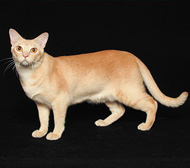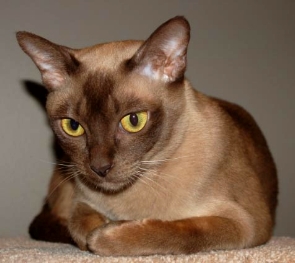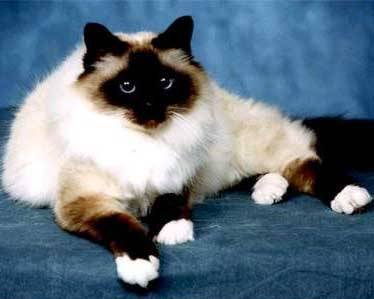Anyone who enjoys the personality and temperament of an American Burmese, but find its oddly round head displeasing, the European Burmese may merit looking into.
History
As a direct descendant of the American Burmese, these cats all originated from temple cats in Burma. The legend states that the original temple cats were pure white in coat and suddenly changed color to match the goddess the monks worshipped. However, cat lover’s have a less fanciful explanation for how these cats came to be. It is thought that a Siamese wandered into the temple and fathered a few litters of kittens. After their creation, the American Burmese did not arrive in Europe until the end of World War II.
Appearance
Obtaining the name European Burmese took a lot of hard work and dedication on the breeder’s part. Being concerned with the gene pool being to minimal, they decided to cross breed the American Burmese with the Siamese breed. After several litters, they decided that the oriental appearance the crossbred kittens possessed was more endearing to them then the original appearance of the American Burmese. After several more careful workings in breeding, the distinct look of the European Burmese was created.
The breeder’s were delighted with the creation of the wedge shaped head instead of the oversized round head of the American Burmese. They also were able to develop a much broader spectrum of colors from which to choose including Brown, Chocolate, Red, Blue, Lilac, and Cream colors, as well as tortoiseshell patterns in these colors.
The specific standard for these cats is a more rounded eye with a distinct golden color, though green eyes are also acceptable. The physical characteristics of a European Burmese are its powerful, muscular body with elegantly slender legs and a gracefully tapered tail. On average, the European Burmese will weigh anywhere from eight to fourteen pounds.
Behavior and Characteristics
The personality of a European Burmese is loving and sociable with a laid back attitude. These cats are happy to hang out with family and curl up in the nearest available lap and snooze the day away. Being a social breed, the European Burmese loves companionship, which makes it the perfect addition to a home with other cats or children.
If your career keeps you away from home, then the European Burmese is not the right choice for you as these cats need affection and attention. Although, even if you are at home, having additional cats for your European Burmese to pal around with will keep him happy and content.
Health Problems and Grooming Info
Grooming is an important part of your cats care; however, being a shorthair, the European Burmese should only require a good brushing once a week in order to remove loose hairs and dander. Once a month, you can bathe your Burmese, this helps alleviate excess dander.
In addition to the regular hair grooming, all cats are prone to dental decay and disease, so it is important to implement a regular tooth brushing routine several times a week in order to prevent these diseases from occurring. Another important part of the grooming process is making sure to trim your cat’s nails regularly. Typically, a good trim about once or twice a month will ensure your cat’s nails stay free from cracks, debris and possible infections.
Anyone looking to have a house full of cats and children, and are looking for a sweet natured, loving personality are sure to fall in love with the unique and graceful European Burmese.
History
As a direct descendant of the American Burmese, these cats all originated from temple cats in Burma. The legend states that the original temple cats were pure white in coat and suddenly changed color to match the goddess the monks worshipped. However, cat lover’s have a less fanciful explanation for how these cats came to be. It is thought that a Siamese wandered into the temple and fathered a few litters of kittens. After their creation, the American Burmese did not arrive in Europe until the end of World War II.
Appearance
Obtaining the name European Burmese took a lot of hard work and dedication on the breeder’s part. Being concerned with the gene pool being to minimal, they decided to cross breed the American Burmese with the Siamese breed. After several litters, they decided that the oriental appearance the crossbred kittens possessed was more endearing to them then the original appearance of the American Burmese. After several more careful workings in breeding, the distinct look of the European Burmese was created.
The breeder’s were delighted with the creation of the wedge shaped head instead of the oversized round head of the American Burmese. They also were able to develop a much broader spectrum of colors from which to choose including Brown, Chocolate, Red, Blue, Lilac, and Cream colors, as well as tortoiseshell patterns in these colors.
The specific standard for these cats is a more rounded eye with a distinct golden color, though green eyes are also acceptable. The physical characteristics of a European Burmese are its powerful, muscular body with elegantly slender legs and a gracefully tapered tail. On average, the European Burmese will weigh anywhere from eight to fourteen pounds.
Behavior and Characteristics
The personality of a European Burmese is loving and sociable with a laid back attitude. These cats are happy to hang out with family and curl up in the nearest available lap and snooze the day away. Being a social breed, the European Burmese loves companionship, which makes it the perfect addition to a home with other cats or children.
If your career keeps you away from home, then the European Burmese is not the right choice for you as these cats need affection and attention. Although, even if you are at home, having additional cats for your European Burmese to pal around with will keep him happy and content.
Health Problems and Grooming Info
Grooming is an important part of your cats care; however, being a shorthair, the European Burmese should only require a good brushing once a week in order to remove loose hairs and dander. Once a month, you can bathe your Burmese, this helps alleviate excess dander.
In addition to the regular hair grooming, all cats are prone to dental decay and disease, so it is important to implement a regular tooth brushing routine several times a week in order to prevent these diseases from occurring. Another important part of the grooming process is making sure to trim your cat’s nails regularly. Typically, a good trim about once or twice a month will ensure your cat’s nails stay free from cracks, debris and possible infections.
Anyone looking to have a house full of cats and children, and are looking for a sweet natured, loving personality are sure to fall in love with the unique and graceful European Burmese.




 RSS Feed
RSS Feed